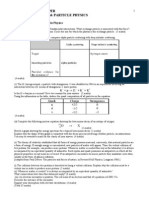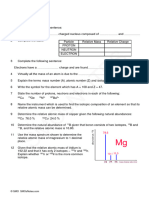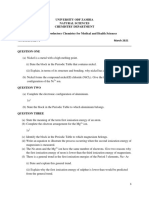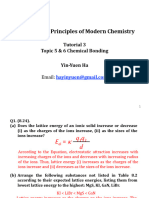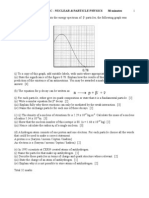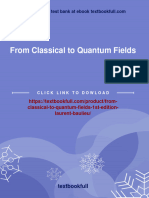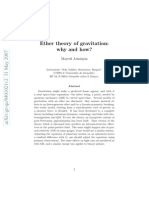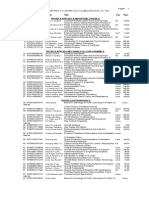0 ratings0% found this document useful (0 votes)
18 viewsPHY3 CJanuary 2003
PHY3 CJanuary 2003
Uploaded by
api-3726022This document contains a physics exam with multiple questions on nuclear and particle physics topics:
1) A calculation question involving binding energy per nucleon for oxygen-16 isotope.
2) A diagram labeling question involving binding energy per nucleon graph and key isotopes.
3) Several conceptual questions about fundamental particles, leptons, quarks, and interactions between particles defined by Feynman diagrams.
The exam covers nuclear stability, particle identification and classification, and basic strong and weak force interactions defined by standard model exchanges.
Copyright:
Attribution Non-Commercial (BY-NC)
Available Formats
Download as DOC, PDF, TXT or read online from Scribd
PHY3 CJanuary 2003
PHY3 CJanuary 2003
Uploaded by
api-37260220 ratings0% found this document useful (0 votes)
18 views1 pageThis document contains a physics exam with multiple questions on nuclear and particle physics topics:
1) A calculation question involving binding energy per nucleon for oxygen-16 isotope.
2) A diagram labeling question involving binding energy per nucleon graph and key isotopes.
3) Several conceptual questions about fundamental particles, leptons, quarks, and interactions between particles defined by Feynman diagrams.
The exam covers nuclear stability, particle identification and classification, and basic strong and weak force interactions defined by standard model exchanges.
Original Description:
Original Title
PHY3CJanuary2003
Copyright
© Attribution Non-Commercial (BY-NC)
Available Formats
DOC, PDF, TXT or read online from Scribd
Share this document
Did you find this document useful?
Is this content inappropriate?
This document contains a physics exam with multiple questions on nuclear and particle physics topics:
1) A calculation question involving binding energy per nucleon for oxygen-16 isotope.
2) A diagram labeling question involving binding energy per nucleon graph and key isotopes.
3) Several conceptual questions about fundamental particles, leptons, quarks, and interactions between particles defined by Feynman diagrams.
The exam covers nuclear stability, particle identification and classification, and basic strong and weak force interactions defined by standard model exchanges.
Copyright:
Attribution Non-Commercial (BY-NC)
Available Formats
Download as DOC, PDF, TXT or read online from Scribd
Download as doc, pdf, or txt
0 ratings0% found this document useful (0 votes)
18 views1 pagePHY3 CJanuary 2003
PHY3 CJanuary 2003
Uploaded by
api-3726022This document contains a physics exam with multiple questions on nuclear and particle physics topics:
1) A calculation question involving binding energy per nucleon for oxygen-16 isotope.
2) A diagram labeling question involving binding energy per nucleon graph and key isotopes.
3) Several conceptual questions about fundamental particles, leptons, quarks, and interactions between particles defined by Feynman diagrams.
The exam covers nuclear stability, particle identification and classification, and basic strong and weak force interactions defined by standard model exchanges.
Copyright:
Attribution Non-Commercial (BY-NC)
Available Formats
Download as DOC, PDF, TXT or read online from Scribd
Download as doc, pdf, or txt
You are on page 1of 1
PHY3 JANUARY 2003 - TOPIC C - NUCLEAR & PARTICLE PHYSICS 1
Topic C - Nuclear and Particle Physics
3. (a) Use the data below to calculate the binding energy in MeV of a nucleus of oxygen, 168O.
Data: mass of proton = 1.007 276 u; mass of neutron = 1.008 665 u; mass of oxygen nucleus = 15.990 527 u (3)
Calculate the binding energy per nucleon of 168O. (1)
On a copy of the axes opposite sketch a graph of
binding energy per nucleon against nucleon number. (2)
Show on the graph the approximate position of
(i) oxygen, labelling this point O,
(ii) iron, the most stable element, labelling this point Fe,
(iii) uranium, 23892U, labelling this point U. (3)
(b) The Feynman diagram opposite represents an interaction
between an antineutrino and a proton, known as inverse beta decay.
Write an equation for this interaction. (1)
Show that charge is conserved in this interaction. (1)
What type of interaction is responsible for inverse beta decay? (1)
Justify your answer. (1)
What exchange particle is involved? (2)
Suggest why the interaction is known as inverse beta decay. (2)
(c) State what is meant by a fundamental particle.
Which of the following are fundamental particles?
[ positron; neutron; muon; K° meson. ] (3)
Explain why it is not possible to have a meson with a charge of +2. You may be awarded a mark for the clarity of your
answer. (3)
(d) Read the short passage below and answer the questions about it.
Give an example of a lepton. (1)
How do we know that leptons carry no colour charge? (1)
State one possible coloured quark combination for a proton. (2)
Three coloured quark combinations for a π - meson are listed below. For each example state whether it is a possible or
an impossible combination and explain your answer. (4)
What type of particle is a gluon? (1)
(Total 32 marks)
You might also like
- PHY3 CJune 2002Document1 pagePHY3 CJune 2002api-3726022No ratings yet
- PHY3 CJanuary 2006Document1 pagePHY3 CJanuary 2006api-3726022No ratings yet
- Phy 3 C SpecimenDocument1 pagePhy 3 C Specimennahian_aziz9050No ratings yet
- SCT 131 General Chemistry CA1 CA2 Proper-1Document2 pagesSCT 131 General Chemistry CA1 CA2 Proper-1JensiNo ratings yet
- Atoms & NucleiDocument15 pagesAtoms & NucleixkryxxzNo ratings yet
- Atomic Structure QuestionsDocument4 pagesAtomic Structure QuestionsHovan Tall Nut TanNo ratings yet
- CH 1002 Assn 1Document3 pagesCH 1002 Assn 1DorothyNo ratings yet
- Structure of The Atom and The Periodic Table QDocument4 pagesStructure of The Atom and The Periodic Table QMutula NashonNo ratings yet
- Atomic Structure TutorialDocument3 pagesAtomic Structure Tutorialchong56No ratings yet
- Homework (II) ForextrascoreDocument3 pagesHomework (II) Forextrascore張廷No ratings yet
- Questions on Fundamental Particles: Cs Cs Cs Cs β β β βDocument10 pagesQuestions on Fundamental Particles: Cs Cs Cs Cs β β β βjoeNo ratings yet
- CBSE Class 12 Physics: Atoms and Nuclei QuestionsDocument4 pagesCBSE Class 12 Physics: Atoms and Nuclei QuestionsBug LordNo ratings yet
- IB SL Checklist Atomic StructureDocument2 pagesIB SL Checklist Atomic Structurevccc8dh77vNo ratings yet
- Xii-Board 3RD 33% Physics QP - 18.11.2023Document7 pagesXii-Board 3RD 33% Physics QP - 18.11.2023eashwarsiddhaNo ratings yet
- CHEM 101 LECTURE NOTE On Mass Spectrometer and Quantum Theory - E. N DIMDocument21 pagesCHEM 101 LECTURE NOTE On Mass Spectrometer and Quantum Theory - E. N DIMDoctor ChetanneNo ratings yet
- EDC 313 Inorg III AnswersheetDocument10 pagesEDC 313 Inorg III AnswersheetmicharshuttyNo ratings yet
- Foundation Chemistry I - CHM 092 July - Nov 2020 Tutorial 4 (Topic 2)Document3 pagesFoundation Chemistry I - CHM 092 July - Nov 2020 Tutorial 4 (Topic 2)MUHAMMAD LUQMAN HAKIMI MOHD ZAMRINo ratings yet
- Science Department: Topic 7.1 - Discrete Energy & Radioactivity Topic 7.2 - Nuclear Reactions 12 Grade (Physics SL)Document8 pagesScience Department: Topic 7.1 - Discrete Energy & Radioactivity Topic 7.2 - Nuclear Reactions 12 Grade (Physics SL)ananNo ratings yet
- CH 11 Problems 5th EditionDocument3 pagesCH 11 Problems 5th Editionnisannn0% (1)
- CHE 1010 Tutorial Sheet 3Document5 pagesCHE 1010 Tutorial Sheet 3Chimuka Onson MapikiNo ratings yet
- Che 222 Practice Questions 2020aDocument4 pagesChe 222 Practice Questions 2020adoreenrose739No ratings yet
- Chemistry Related Exam Questions and AnswersDocument11 pagesChemistry Related Exam Questions and AnswersJoseph NyabugaNo ratings yet
- Nuclei: 29. A nucleus undergoes through α-decay and transforms to thorium. What isDocument3 pagesNuclei: 29. A nucleus undergoes through α-decay and transforms to thorium. What isShrvan SudhakarNo ratings yet
- Stiso H W Topic 2 QuestionsDocument7 pagesStiso H W Topic 2 Questionsapi-235839943No ratings yet
- General Chemistry I - Tutorials 2 and 3Document15 pagesGeneral Chemistry I - Tutorials 2 and 3Duc Anh NguyenNo ratings yet
- CH 4Document13 pagesCH 4Khushi RawatNo ratings yet
- PRB Set 2Document3 pagesPRB Set 2Aya HachanaNo ratings yet
- CHEM1070A: Principles of Modern Chemistry: Tutorial 3 Topic 5 & 6 Chemical BondingDocument8 pagesCHEM1070A: Principles of Modern Chemistry: Tutorial 3 Topic 5 & 6 Chemical BondingmirandatwongNo ratings yet
- Particle Physics WorksheetDocument6 pagesParticle Physics WorksheetPercy Carlos KasambiraNo ratings yet
- Topic 1: Atomic Structure and The Periodic Table - Part 1Document4 pagesTopic 1: Atomic Structure and The Periodic Table - Part 1MohamudNo ratings yet
- 3.5.1 Practice - Bonding in Matter (Practice)Document17 pages3.5.1 Practice - Bonding in Matter (Practice)russellyeet39No ratings yet
- Short Ans CH 5-Electricity and Magnetism SL Level-2: (170 Marks)Document30 pagesShort Ans CH 5-Electricity and Magnetism SL Level-2: (170 Marks)Hiya ShahNo ratings yet
- 7 Atomic Nuclear Paper1 1Document28 pages7 Atomic Nuclear Paper1 1portaliteNo ratings yet
- PS9001-CA Quiz AY 2015/16Document4 pagesPS9001-CA Quiz AY 2015/16Matthias Ecclesiastes TanNo ratings yet
- Subatomic Problem Set 1: Radioactivity and Nuclear StabilityDocument32 pagesSubatomic Problem Set 1: Radioactivity and Nuclear StabilityDiego M GranziolNo ratings yet
- Atomic Structure Exercises by ResonanceDocument35 pagesAtomic Structure Exercises by Resonancechiragjn12086% (7)
- PHY3 CJune 2006Document1 pagePHY3 CJune 2006api-3726022No ratings yet
- AtomicNuclear Core P1Document23 pagesAtomicNuclear Core P1Franchesca Rosabel BudimanNo ratings yet
- Dse 3Document6 pagesDse 3jahidrajaqwertNo ratings yet
- Tutorial # 4 - Chemical Bonding Semester1 2015-16Document2 pagesTutorial # 4 - Chemical Bonding Semester1 2015-16Tericka JohnsonNo ratings yet
- General Chemistry I - Tutorial 2Document13 pagesGeneral Chemistry I - Tutorial 2Duc Anh NguyenNo ratings yet
- Atomic StructureDocument30 pagesAtomic Structurenaeem mushtaqNo ratings yet
- CHE 123 - Worksheet - Atomic Structure - IonizationDocument6 pagesCHE 123 - Worksheet - Atomic Structure - IonizationJanet UsherNo ratings yet
- NEW Radioactivity GuideDocument21 pagesNEW Radioactivity Guidebezoz420No ratings yet
- PHY3 CJanuary 2005Document1 pagePHY3 CJanuary 2005api-3726022No ratings yet
- Practice Test - Properties and Structure of Atom ANSDocument7 pagesPractice Test - Properties and Structure of Atom ANStinyteddy452No ratings yet
- CHP 8Document3 pagesCHP 8aysekrzm07No ratings yet
- Sample Paper XIDocument4 pagesSample Paper XIabhaas.arora.delhiNo ratings yet
- Modern Physics PDFDocument46 pagesModern Physics PDFMarcos ShepardNo ratings yet
- Chem 6Document10 pagesChem 60No ratings yet
- STD 8 Chapter 5Document6 pagesSTD 8 Chapter 5ROHIT KADAMNo ratings yet
- Nuclear Tutorial SolutionDocument19 pagesNuclear Tutorial SolutionGordon GohNo ratings yet
- WS - Honors Atomic Theory WSDocument9 pagesWS - Honors Atomic Theory WSsquattingm0nkeysNo ratings yet
- Chapter 8Document28 pagesChapter 8talktotiffanychengNo ratings yet
- One Mark QuestionsDocument4 pagesOne Mark Questionshari95No ratings yet
- Exam1 PracticeDocument9 pagesExam1 PracticeTruong Cai100% (1)
- Ach 110 AssignmentDocument8 pagesAch 110 AssignmentJoseph NyabugaNo ratings yet
- Electron Beam-Specimen Interactions and Simulation Methods in MicroscopyFrom EverandElectron Beam-Specimen Interactions and Simulation Methods in MicroscopyNo ratings yet
- Negative Mass and Negative Refractive Index in Atom Nuclei - Nuclear Wave Equation - Gravitational and Inertial Control: Part 5: Gravitational and Inertial Control, #5From EverandNegative Mass and Negative Refractive Index in Atom Nuclei - Nuclear Wave Equation - Gravitational and Inertial Control: Part 5: Gravitational and Inertial Control, #5No ratings yet
- Negative Mass and Negative Refractive Index in Atom Nuclei - Nuclear Wave Equation - Gravitational and Inertial Control: Part 2: Gravitational and Inertial Control, #2From EverandNegative Mass and Negative Refractive Index in Atom Nuclei - Nuclear Wave Equation - Gravitational and Inertial Control: Part 2: Gravitational and Inertial Control, #2No ratings yet
- 6102 01 Que 20080109Document20 pages6102 01 Que 20080109Inas ManurungNo ratings yet
- PHY3 DJune 2006Document1 pagePHY3 DJune 2006api-3726022No ratings yet
- Unit 1 Exam Jan 2002Document16 pagesUnit 1 Exam Jan 2002Öykü TuralNo ratings yet
- Biology Jan 2008 6101 QuestionDocument20 pagesBiology Jan 2008 6101 QuestionAdrees MeahNo ratings yet
- Biojune 2008 U1qDocument16 pagesBiojune 2008 U1qapi-3726022No ratings yet
- PHY3 DJune 2005Document1 pagePHY3 DJune 2005api-3726022No ratings yet
- PHY3 DJune 2002Document1 pagePHY3 DJune 2002api-3726022No ratings yet
- PHY3 DJune 2004Document1 pagePHY3 DJune 2004api-3726022No ratings yet
- PHY3 DJanuary 2005Document1 pagePHY3 DJanuary 2005api-3726022No ratings yet
- PHY3 DJanuary 2004Document1 pagePHY3 DJanuary 2004api-3726022No ratings yet
- PHY3 DJanuary 2002Document1 pagePHY3 DJanuary 2002api-3726022No ratings yet
- PHY3 CJune 2006Document1 pagePHY3 CJune 2006api-3726022No ratings yet
- PHY3 CJune 2004Document1 pagePHY3 CJune 2004api-3726022No ratings yet
- PHY3 CJanuary 2005Document1 pagePHY3 CJanuary 2005api-3726022No ratings yet
- PHY3 AJune 2005Document1 pagePHY3 AJune 2005api-3726022No ratings yet
- PHY3 AJune 2006Document1 pagePHY3 AJune 2006api-3726022No ratings yet
- PHY3 AJanuary 2006Document1 pagePHY3 AJanuary 2006api-3726022No ratings yet
- PHY3 AJune 2004Document1 pagePHY3 AJune 2004api-3726022No ratings yet
- PHY3 AJune 2003Document1 pagePHY3 AJune 2003api-3726022No ratings yet
- PHY3 AJanuary 2004Document1 pagePHY3 AJanuary 2004api-3726022No ratings yet
- Instant Download From Classical To Quantum Fields 1st Edition Laurent Baulieu PDF All ChapterDocument53 pagesInstant Download From Classical To Quantum Fields 1st Edition Laurent Baulieu PDF All Chapterleksiyalina100% (2)
- CVDocument16 pagesCVbanti2659No ratings yet
- Info Physics of Geant 4Document39 pagesInfo Physics of Geant 4ClarettaNo ratings yet
- Fuzzy Space Time, Quantum Geometry and Cosmology PDFDocument29 pagesFuzzy Space Time, Quantum Geometry and Cosmology PDFJohn BirdNo ratings yet
- Thesis SADMANDocument27 pagesThesis SADMANSadman Zarif HOssainNo ratings yet
- Nuclei (1) Super Class 12 100 MarksDocument10 pagesNuclei (1) Super Class 12 100 MarksSHASHWAT VARDHAN SINGHNo ratings yet
- Generalised Angular MomentumDocument10 pagesGeneralised Angular MomentumGourab HazraNo ratings yet
- Particle Physics Brian R. Martin Download PDFDocument53 pagesParticle Physics Brian R. Martin Download PDFlucayajsha10100% (1)
- %XK Xk-Ig Ka XK.: Antigravity: A Crazy Idea? RDocument3 pages%XK Xk-Ig Ka XK.: Antigravity: A Crazy Idea? RresadNo ratings yet
- The Structure of MatterDocument5 pagesThe Structure of MatterHugh BlythNo ratings yet
- Galvagno 2005Document15 pagesGalvagno 2005Emanuel GarciaNo ratings yet
- Mayeul Arminjon - Ether Theory of Gravitation: Why and How?Document60 pagesMayeul Arminjon - Ether Theory of Gravitation: Why and How?OppekeeNo ratings yet
- J. Wheeler - Information, Physics, Quantum - The Search For LinksDocument15 pagesJ. Wheeler - Information, Physics, Quantum - The Search For LinksNicolas100% (1)
- Capstone Thesis Jens MaluckDocument73 pagesCapstone Thesis Jens Maluckninicita22No ratings yet
- Wilson Notes PDFDocument2 pagesWilson Notes PDFPhD LIVENo ratings yet
- SBTP CH HGDocument8 pagesSBTP CH HGGautam MondalNo ratings yet
- The Proca Field and Symmetry Breaking / Mass Generation - As Seen From The Vantage Point of Classical Field Theory.Document7 pagesThe Proca Field and Symmetry Breaking / Mass Generation - As Seen From The Vantage Point of Classical Field Theory.Rock BrentwoodNo ratings yet
- Scalar Field TheoryDocument9 pagesScalar Field Theoryemanala2015No ratings yet
- Advances in Quantum Field TheoryDocument242 pagesAdvances in Quantum Field TheoryEd_afvNo ratings yet
- Generalized Fierz Identities PDFDocument18 pagesGeneralized Fierz Identities PDFzcapg17No ratings yet
- 02 Structure of Atom CN (02-06-22) - MinDocument2 pages02 Structure of Atom CN (02-06-22) - Minnandukr.8083No ratings yet
- Textbook Strongly Interacting Quantum Systems Out of Equilibrium Lecture Notes of The Les Houches Summer School Volume 99 30Th July 24Th August 2012 1St Edition Thierry Giamarchi Ebook All Chapter PDFDocument54 pagesTextbook Strongly Interacting Quantum Systems Out of Equilibrium Lecture Notes of The Les Houches Summer School Volume 99 30Th July 24Th August 2012 1St Edition Thierry Giamarchi Ebook All Chapter PDFshirley.taylor831100% (5)
- Research Paper 2Document2 pagesResearch Paper 2jtydNo ratings yet
- DeWitt Quantum Gravity 2Document45 pagesDeWitt Quantum Gravity 2Gleb AnanyevNo ratings yet
- Saeed Book Bank: S.# Isbn/Tag Author Title Cur. PriceDocument20 pagesSaeed Book Bank: S.# Isbn/Tag Author Title Cur. PriceMubeenNo ratings yet
- Beginning With The End - God, Science, and Wolfhart PannenbergDocument33 pagesBeginning With The End - God, Science, and Wolfhart PannenbergPedro Fernandez50% (2)
- Gravity and Anti-GravityDocument31 pagesGravity and Anti-GravitySergio Fiuza FiuzaNo ratings yet
- Schweber 2014Document39 pagesSchweber 2014Ray MondoNo ratings yet
- Scattering Processes Could Distinguish Majorana From Dirac Neutrinos J.Barranco, D.Delepine 2014Document5 pagesScattering Processes Could Distinguish Majorana From Dirac Neutrinos J.Barranco, D.Delepine 2014FRANK BULA MARTINEZNo ratings yet
- CCST 2018 8585474Document7 pagesCCST 2018 8585474Chithra ShineyNo ratings yet


